-
 Young Women’s Attendance Room 2nd Floor - Room 50.
Young Women’s Attendance Room 2nd Floor - Room 50. This is another image potentially depicting one of the Friday Conversations, which were voluntary meetings that all female students were invited to attend. During these conversations female faculty members would teach the young women about subjects of practical and professional character. Despite being voluntary, the meetings were well attended as faculty members offered the young women life advice that they would not have the chance to learn in the classroom.
-
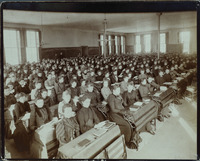 Young Women’s Attendance Room 2nd Floor - Room 50.
Young Women’s Attendance Room 2nd Floor - Room 50. This image depicts female students gathered in an attendance room, perhaps for one of the “Friday Conversations,” that occurred on three Friday afternoons during the school year. These “conversations” would be led by the women faculty members of the Normal, and would last about an hour. The woman standing in the middle at the back of the classroom is likely the head of the History Department, and Preceptress, Julia Anne King. King’s obituary published in the Detroit Free Press in 1919 stated, “Miss. King was unquestionably the best woman educator Michigan has ever had.”
-
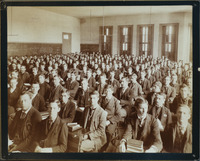 Young Mens Attendance Hall 2nd Floor - Room 37.
Young Mens Attendance Hall 2nd Floor - Room 37. This image depicts male students gathered in an attendance room, and it was possibly taken during one of three yearly “Friday Conversations” led by the Principal or other male staff members. The discussions during the young men’s meetings covered a broad range of topics that were “chiefly determined by passing interests” (Normal Register 1893-94, p.36). These conversations were informal, and followed no schedule or structure.
-
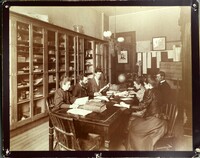 Training School Office of Director Prof. Austin George, T.S. Director.
Training School Office of Director Prof. Austin George, T.S. Director. This image depicts a meeting in the office of the Director of the Training School, Professor Austin George (pictured sitting in the middle on the left side of the table). During the summer of 1863, the same year George graduated from the MSNS, he organized Company E of the 17th Michigan Infantry in the Civil War. After graduating, George moved to Kalamazoo where he worked several positions within the Kalamazoo Public School system, and established a Training School. George returned to the MSNS in 1881, the same year he proposed and started The Normal News, and a year later accepted his role as the Director of the Training School. After significantly expanding and strengthening the Training School curriculum, George left the Normal in 1896 to accept a position as the Superintendent of the Ypsilanti Public Schools.
-
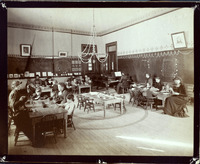 Training School Kindergarten First Floor - Room 24.
Training School Kindergarten First Floor - Room 24. This image depicts a Kindergarten Training School class, which was considered to be a precursor to the “Primary Grades” beginning in first grade. Students as young as four were admitted into the Kindergarten class. The coursework for kindergarteners at the Normal School was rather craft-centric as the register book notes that the children were instructed in over eight different types of crafting from clay-modeling to mat-weaving. Student teachers who wished to work with the Kindergarteners were required to have the ability to sing simple tunes correctly as well as possess “knowledge of pianoforte playing as is required to render the songs and marches of the Kindergarten” in order to graduate.
-
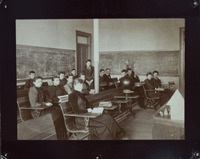 Training School 9th Grade Algebra.
Training School 9th Grade Algebra. This image depicts a 9th grade class, and despite the caption reading “Training School 9th grade”, this grade was not technically part of the training school, but was created to ease the transition between the Training School and Normal School coursework. As such, there was no specific instructor for 9th grade and students were taught by the same instructors as Normal School students. Additionally, ninth grade students were required to choose either the Classical or the English and Scientific Course in order to determine what classes they would be taking, and when. The main difference between the two courses was that Classical students took Latin or German throughout the year, and English and Science students took English classes.
-
 Training school 8th grade 1st floor - room 7
Training school 8th grade 1st floor - room 7 This image depicts an 8th grade Training School class, being led by student teacher K. Maude Cady, who is likely the woman standing behind the podium. Mathematics instruction expanded to cover Algebra in this year, and Geometry lessons were given daily (7th graders only received one lesson a week). U.S. History was also added to the curriculum for eighth graders in the latter half of the year, and the lessons focused on discovery, colonization/settlement, wars, and the overall development of the United States. There was still no organized science curriculum for Training School students in 8th grade, but students were taught about astronomy and meteorology as a part of their “General Lessons” work.
-
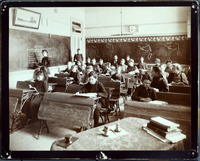 Training School 7th Grade First Floor Room 8-9.
Training School 7th Grade First Floor Room 8-9. This image depicts a class of 7th grade Training School students, many of whom have their faces buried in their books. This was the first grade to move on from solely focusing on arithmetic, as students had Geometry lessons one day per week. Additionally, Seventh grade was also the first year students learned about the world outside of the Americas in Geography class, as the curriculum focused on “Old World studies” which included the study of Europe, Asia, Polynesia, and Africa. There was no history in the curriculum for Training School students until 8th grade.
-
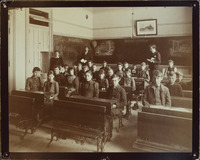 Training School 6th Grade First Floor - Room 10-11
Training School 6th Grade First Floor - Room 10-11 This image depicts a 6th grade Training School class, which was taught by Winnie Robinson, who is likely the adult woman who is standing at the side of the classroom. Grammar lessons were emphasized in this grade, as the most detailed subject in the 6th grade curriculum was Language. Language lessons covered a large array of topics such as sentence structure, syntax, and manuscript work. Additionally, the sixth graders were taught about the dangers of stimulants and narcotics as a part of their General Lessons curriculum.
-
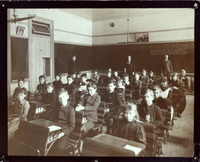 Training School 4th Grade 1st floor Room 15-16.
Training School 4th Grade 1st floor Room 15-16. This image depicts a 4th grade Training School class taught by student teacher Mary Blount, who is likely the woman standing in the back of the classroom. Fourth grade was the last of the “Primary Grades” before moving into the “Grammar Grades” which began at grade 5. Fourth graders in 1892 studied similar subjects to those taught in modern elementary schools, such as reading and writing, spelling, math, art, and music. While there was no science curriculum for 4th grade students, students in this grade learned about personal hygiene and were given oral lessons in physiology.
 Young Women’s Attendance Room 2nd Floor - Room 50. This is another image potentially depicting one of the Friday Conversations, which were voluntary meetings that all female students were invited to attend. During these conversations female faculty members would teach the young women about subjects of practical and professional character. Despite being voluntary, the meetings were well attended as faculty members offered the young women life advice that they would not have the chance to learn in the classroom.
Young Women’s Attendance Room 2nd Floor - Room 50. This is another image potentially depicting one of the Friday Conversations, which were voluntary meetings that all female students were invited to attend. During these conversations female faculty members would teach the young women about subjects of practical and professional character. Despite being voluntary, the meetings were well attended as faculty members offered the young women life advice that they would not have the chance to learn in the classroom. Young Women’s Attendance Room 2nd Floor - Room 50. This image depicts female students gathered in an attendance room, perhaps for one of the “Friday Conversations,” that occurred on three Friday afternoons during the school year. These “conversations” would be led by the women faculty members of the Normal, and would last about an hour. The woman standing in the middle at the back of the classroom is likely the head of the History Department, and Preceptress, Julia Anne King. King’s obituary published in the Detroit Free Press in 1919 stated, “Miss. King was unquestionably the best woman educator Michigan has ever had.”
Young Women’s Attendance Room 2nd Floor - Room 50. This image depicts female students gathered in an attendance room, perhaps for one of the “Friday Conversations,” that occurred on three Friday afternoons during the school year. These “conversations” would be led by the women faculty members of the Normal, and would last about an hour. The woman standing in the middle at the back of the classroom is likely the head of the History Department, and Preceptress, Julia Anne King. King’s obituary published in the Detroit Free Press in 1919 stated, “Miss. King was unquestionably the best woman educator Michigan has ever had.” Young Mens Attendance Hall 2nd Floor - Room 37. This image depicts male students gathered in an attendance room, and it was possibly taken during one of three yearly “Friday Conversations” led by the Principal or other male staff members. The discussions during the young men’s meetings covered a broad range of topics that were “chiefly determined by passing interests” (Normal Register 1893-94, p.36). These conversations were informal, and followed no schedule or structure.
Young Mens Attendance Hall 2nd Floor - Room 37. This image depicts male students gathered in an attendance room, and it was possibly taken during one of three yearly “Friday Conversations” led by the Principal or other male staff members. The discussions during the young men’s meetings covered a broad range of topics that were “chiefly determined by passing interests” (Normal Register 1893-94, p.36). These conversations were informal, and followed no schedule or structure. Training School Office of Director Prof. Austin George, T.S. Director. This image depicts a meeting in the office of the Director of the Training School, Professor Austin George (pictured sitting in the middle on the left side of the table). During the summer of 1863, the same year George graduated from the MSNS, he organized Company E of the 17th Michigan Infantry in the Civil War. After graduating, George moved to Kalamazoo where he worked several positions within the Kalamazoo Public School system, and established a Training School. George returned to the MSNS in 1881, the same year he proposed and started The Normal News, and a year later accepted his role as the Director of the Training School. After significantly expanding and strengthening the Training School curriculum, George left the Normal in 1896 to accept a position as the Superintendent of the Ypsilanti Public Schools.
Training School Office of Director Prof. Austin George, T.S. Director. This image depicts a meeting in the office of the Director of the Training School, Professor Austin George (pictured sitting in the middle on the left side of the table). During the summer of 1863, the same year George graduated from the MSNS, he organized Company E of the 17th Michigan Infantry in the Civil War. After graduating, George moved to Kalamazoo where he worked several positions within the Kalamazoo Public School system, and established a Training School. George returned to the MSNS in 1881, the same year he proposed and started The Normal News, and a year later accepted his role as the Director of the Training School. After significantly expanding and strengthening the Training School curriculum, George left the Normal in 1896 to accept a position as the Superintendent of the Ypsilanti Public Schools. Training School Kindergarten First Floor - Room 24. This image depicts a Kindergarten Training School class, which was considered to be a precursor to the “Primary Grades” beginning in first grade. Students as young as four were admitted into the Kindergarten class. The coursework for kindergarteners at the Normal School was rather craft-centric as the register book notes that the children were instructed in over eight different types of crafting from clay-modeling to mat-weaving. Student teachers who wished to work with the Kindergarteners were required to have the ability to sing simple tunes correctly as well as possess “knowledge of pianoforte playing as is required to render the songs and marches of the Kindergarten” in order to graduate.
Training School Kindergarten First Floor - Room 24. This image depicts a Kindergarten Training School class, which was considered to be a precursor to the “Primary Grades” beginning in first grade. Students as young as four were admitted into the Kindergarten class. The coursework for kindergarteners at the Normal School was rather craft-centric as the register book notes that the children were instructed in over eight different types of crafting from clay-modeling to mat-weaving. Student teachers who wished to work with the Kindergarteners were required to have the ability to sing simple tunes correctly as well as possess “knowledge of pianoforte playing as is required to render the songs and marches of the Kindergarten” in order to graduate. Training School 9th Grade Algebra. This image depicts a 9th grade class, and despite the caption reading “Training School 9th grade”, this grade was not technically part of the training school, but was created to ease the transition between the Training School and Normal School coursework. As such, there was no specific instructor for 9th grade and students were taught by the same instructors as Normal School students. Additionally, ninth grade students were required to choose either the Classical or the English and Scientific Course in order to determine what classes they would be taking, and when. The main difference between the two courses was that Classical students took Latin or German throughout the year, and English and Science students took English classes.
Training School 9th Grade Algebra. This image depicts a 9th grade class, and despite the caption reading “Training School 9th grade”, this grade was not technically part of the training school, but was created to ease the transition between the Training School and Normal School coursework. As such, there was no specific instructor for 9th grade and students were taught by the same instructors as Normal School students. Additionally, ninth grade students were required to choose either the Classical or the English and Scientific Course in order to determine what classes they would be taking, and when. The main difference between the two courses was that Classical students took Latin or German throughout the year, and English and Science students took English classes. Training school 8th grade 1st floor - room 7 This image depicts an 8th grade Training School class, being led by student teacher K. Maude Cady, who is likely the woman standing behind the podium. Mathematics instruction expanded to cover Algebra in this year, and Geometry lessons were given daily (7th graders only received one lesson a week). U.S. History was also added to the curriculum for eighth graders in the latter half of the year, and the lessons focused on discovery, colonization/settlement, wars, and the overall development of the United States. There was still no organized science curriculum for Training School students in 8th grade, but students were taught about astronomy and meteorology as a part of their “General Lessons” work.
Training school 8th grade 1st floor - room 7 This image depicts an 8th grade Training School class, being led by student teacher K. Maude Cady, who is likely the woman standing behind the podium. Mathematics instruction expanded to cover Algebra in this year, and Geometry lessons were given daily (7th graders only received one lesson a week). U.S. History was also added to the curriculum for eighth graders in the latter half of the year, and the lessons focused on discovery, colonization/settlement, wars, and the overall development of the United States. There was still no organized science curriculum for Training School students in 8th grade, but students were taught about astronomy and meteorology as a part of their “General Lessons” work. Training School 7th Grade First Floor Room 8-9. This image depicts a class of 7th grade Training School students, many of whom have their faces buried in their books. This was the first grade to move on from solely focusing on arithmetic, as students had Geometry lessons one day per week. Additionally, Seventh grade was also the first year students learned about the world outside of the Americas in Geography class, as the curriculum focused on “Old World studies” which included the study of Europe, Asia, Polynesia, and Africa. There was no history in the curriculum for Training School students until 8th grade.
Training School 7th Grade First Floor Room 8-9. This image depicts a class of 7th grade Training School students, many of whom have their faces buried in their books. This was the first grade to move on from solely focusing on arithmetic, as students had Geometry lessons one day per week. Additionally, Seventh grade was also the first year students learned about the world outside of the Americas in Geography class, as the curriculum focused on “Old World studies” which included the study of Europe, Asia, Polynesia, and Africa. There was no history in the curriculum for Training School students until 8th grade. Training School 6th Grade First Floor - Room 10-11 This image depicts a 6th grade Training School class, which was taught by Winnie Robinson, who is likely the adult woman who is standing at the side of the classroom. Grammar lessons were emphasized in this grade, as the most detailed subject in the 6th grade curriculum was Language. Language lessons covered a large array of topics such as sentence structure, syntax, and manuscript work. Additionally, the sixth graders were taught about the dangers of stimulants and narcotics as a part of their General Lessons curriculum.
Training School 6th Grade First Floor - Room 10-11 This image depicts a 6th grade Training School class, which was taught by Winnie Robinson, who is likely the adult woman who is standing at the side of the classroom. Grammar lessons were emphasized in this grade, as the most detailed subject in the 6th grade curriculum was Language. Language lessons covered a large array of topics such as sentence structure, syntax, and manuscript work. Additionally, the sixth graders were taught about the dangers of stimulants and narcotics as a part of their General Lessons curriculum. Training School 4th Grade 1st floor Room 15-16. This image depicts a 4th grade Training School class taught by student teacher Mary Blount, who is likely the woman standing in the back of the classroom. Fourth grade was the last of the “Primary Grades” before moving into the “Grammar Grades” which began at grade 5. Fourth graders in 1892 studied similar subjects to those taught in modern elementary schools, such as reading and writing, spelling, math, art, and music. While there was no science curriculum for 4th grade students, students in this grade learned about personal hygiene and were given oral lessons in physiology.
Training School 4th Grade 1st floor Room 15-16. This image depicts a 4th grade Training School class taught by student teacher Mary Blount, who is likely the woman standing in the back of the classroom. Fourth grade was the last of the “Primary Grades” before moving into the “Grammar Grades” which began at grade 5. Fourth graders in 1892 studied similar subjects to those taught in modern elementary schools, such as reading and writing, spelling, math, art, and music. While there was no science curriculum for 4th grade students, students in this grade learned about personal hygiene and were given oral lessons in physiology.